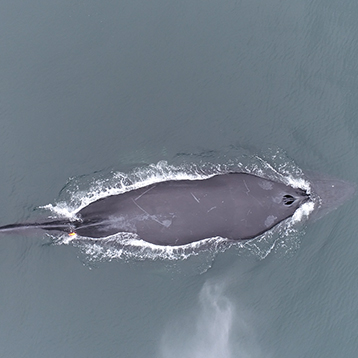Humpback Whale Research & Training
DISCOVERY Yacht Valkyrie
Monterey Bay, California
September 27 - October 4, 2022
Research Team
Dr. Ari Friedlaender, Ph.D.; Ross Nichols, Research Technician; Lauren Fritz, Ph.D. Student; Logan Pallin, Ph.D. Candidate; Arianna Torello, Ph.D. Student; Oksana Savenko, Fulbright Scholar - Ukraine; Vadym Tsachenko, Research Assistant; Blake Marin, Research Assistant.
Purpose of Research
The purpose of this research is to learn about how whales interact with their environment and how environmental change from climate change or human disturbances (noise, pollution,etc.) affect how these animals behave and survive.
From September 27th to October 4th, 2022, the International SeaKeepers Society assisted University of California Santa Cruz’s Dr. Ari Friedlaender and his team to conduct field research on humpback whales in Monterey Bay aboard DISCOVERY Yacht Valkyrie. D/Y Valkyrie is a 65’ Sea Ray L650 FLY.
Over the course of seven days, the two-vessel operation employed a variety of methods. A small rhib-style boat was used to deploy biologgers on the whales using suction cups that adhere easily to a whale’s smooth skin. These biologgers can record data such as orientation and movement of the animals while they’re underwater, how many times does it feed, and other behavioral patterns. Once the biologger detaches itself, it floats at the surface and emits a radio signal. The team uses a VHF antenna from the top deck of Valkyrie to locate the brightly colored tag, so it can be retrieved. UAS or drones are also largely important in this research as it allows researchers to assess the overall health and condition of the whales from a bird’s eye view. Valkyrie proved to be a perfect platform for take-off and landing of the drone. A third method incorporates the use of special darts that take a small biopsy of the whales’ blubber and skin for analysis in the lab. These tissue samples are a treasure trove of data as they can reveal the animal’s diet (through stable isotope analysis), pregnancy hormone levels in females, and stress hormones. Even special genetic markers can help identify individual animals.
A secondary, but equally important goal of this expedition was to train Ph.D. students on how to perform these different procedures so that they can work independently on future expeditions (and more imminently, an expedition in antarctica).
This was a very successful trip and Dr. Friedlaender has expressed interest in working with Captain Petersen and SeaKeepers on an annual basis moving forward.
Application
The research and fieldwork facilitated by the DISCOVERY Yacht Program has allowed renowned scientists well into their careers to training a number of undergraduate and graduate students on cetacean research methods, including radio tracking, photo ID, drone operations, and survey protocols.
The use of drones/UAS from SeaKeepers platforms has been used in four scientific publications do date. The data that was collected allowed scientists to make precise measurements of blue and humpback whales in Monterey Bay to determine length and body condition. Aerial drone video footage was collected on the maneuverability of these species and how they use their flippers and flukes to conduct acrobatic maneuvers while feeding. This work has supported a number of graduate theses and dissertations at UC Santa Cruz, Stanford, and Duke University.
As we continue to facilitate this kind of research, we will be able to learn the long term effects that certain human activities may have on the whales’ environment. Fluctuations in environmental conditions occur over long time cycles, so things like climate change, or overfishing of certain prey can only be studied over long periods of time. Only then can we start to come up with countermeasures which will protect these “eco engineers.” Because a healthy whale population is an indicator of a healthy ocean, we must continue to study and protect these magnificent creatures.
Expedition Goal
The goal of this expedition is to deploy and attach biologging equipment onto whales in the area, collect drone or UAS footage to assess health and conditions of the whales, and to collect blubber and skin biopsies for a full analysis of diet, hormone levels, and genetic markers. A secondary goal was to train Ph.D. students in these methods so they can perform them independently on future expeditions.
Location
Monterey Bay, California

